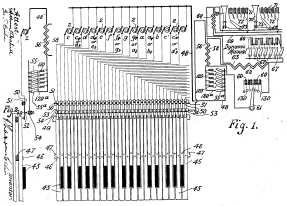In researching the history of the Klavihorn, we came across a couple other, similar instruments:
The Telharmonium was developed by Thaddeus Cahill in 1897.
The Telharmonium with palm fronds as accompaniment
The electrical signal from the Telharmonium was transmitted over wires; it was heard on the receiving end by means of “horn” speakers. The Telharmonium used “tone wheels” to generate musical sounds as electrical signals by additive synthesis. Cahill built three versions: The Mark I version weighed 7 tons. The Mark II version weighed almost 200 tons! (In other words, it wasn’t exactly an instrument suited for marching band.) Some of the first performances were heard at “Telharmonic Hall” at 39th and Broadway in New York. Here is an original Telharmonium blueprint:
No recordings exist of the Telharmonium, and because of its immense weight, size and power consumption, it fell into obscurity. Another interesting tidbit:
“problems began to arise when telephone broadcasts of the Telharmonium were subject to ‘crosstalk’ and unsuspecting telephone users would be interrupted by strange electronic music.” (Wikipedia)
Sounds like John Cage to me.
Another early electronic instrument was the Clavilux, built by Thomas Wilfred in 1919. The Clavilux was a device used to perform “Lumia,” which was Wildred’s term for “Light Art.”
“Lumia as conceived, was a self contained and silent art, not to be combined with music or dance. Wilfred, being a pragmatist, would occasionally experiment or collaborate with other artists and disciplines (most notably for a performance with Maestro Leopold Stokowski and the Philadelphia Symphony at Carnegie Hall) (Wikipedia).
You can buy “5 Thomas Wilfred Lumia Compositions” as well as view visual samples here…
Seattle’s AJ Epstein is currently in the process of restoring a Clavilux, and I’m hoping to create an interdisciplinary duet for the ‘lux and the ‘horn (as I, too, am a pragmatist).
Check out more information about our Klavihorn project, as well as other cool projects happening concurrently.


